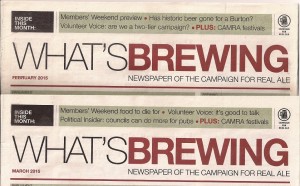 Personal cab, mystery location. Woot! I am still on the Guinness PR agency guest list for The Brewers Project. Regular readers might know that I enjoy the beers but positively gush over the marketing and event organisation from the ‘boys from the black stuff’ and the lovely ladies in their British PR firm.
Personal cab, mystery location. Woot! I am still on the Guinness PR agency guest list for The Brewers Project. Regular readers might know that I enjoy the beers but positively gush over the marketing and event organisation from the ‘boys from the black stuff’ and the lovely ladies in their British PR firm.
It’s clearly an abandoned and long closed pub in a dodgy part of the East End. But no, enter and you find it has been cunningly transformed and used by those nice guys from The Disappearing Dining Club who provided the venue for the first launch of the porters. Excited hubbub downstairs as we revisit the porters we tasted last time (and the porter cocktails).
Then upstairs to a carefully lit room filled with the aroma of hops. And Condiment Junkie. These are the guys behind Heston Blumenthal’s Sounds of the Seashore and other sensory ways of changing our perceptions of food. Yes, our heads were going to be messed with.
At this point the cycnical amongst us might have thought this was going to be to mask any lack of substance in the beer itself. Mmm, maybe, but the touch was light and deft, everyone was there to be entertained and have a good time, not to be sold to.
We tasted the beer with selected foods with different sensory elements – green light/low frequency sounds to emphasise the hop bitterness, red light/high frequency sounds to emphasise the sweetness, sounds of the meadow to emphasise the hops (really?), an extremely malty (and lovely) dessert to emphasise the malt in the beer (dominate perhaps). Did it work? Well the green light/bitter thing worked for me but ultimately it was the food pairings that had more effect, as I guess they should. I would have liked to try the food and light combinations the ‘wrong way round’ to check.
Then back downstairs to try a cocktail made using the beer, Canadian rye, some maple syrup and citrus juice, topped with cream and a malty wafer. Sounds horrible doesn’t it? It was gorgeous as a ‘dessert cocktail’.
What was the beer Rich? Did you like it? So, this was the launch of Guinness Golden ![GUINNESS GOLDEN ALE BOTTLE [HI] half](http://intoxicated.me.uk/wp-content/uploads/2015/03/GUINNESS-GOLDEN-ALE-BOTTLE-HI-half-134x300.jpg) Ale. So far, so bad. I always think of golden ales as being insipid tasteless things designed by cask ale producers to compete with the lager market. So the good news is that this isn’t a golden ale imho. It’s made with ‘specially selected amber malt’ or ‘amber malt’ as the brewer put it. The hops are pelleted Celeia, one of the Styrian family used typically in English ales. A good bittering hop but not an awful lot else.
Ale. So far, so bad. I always think of golden ales as being insipid tasteless things designed by cask ale producers to compete with the lager market. So the good news is that this isn’t a golden ale imho. It’s made with ‘specially selected amber malt’ or ‘amber malt’ as the brewer put it. The hops are pelleted Celeia, one of the Styrian family used typically in English ales. A good bittering hop but not an awful lot else.
This isn’t a complex, micro batch, collaboration craft beer so let’s not overcomplicate the tasting notes. It’s malt rather hop led – Guinness sticking to what they know – and as such tastes like a good English pale ale or ‘ordinary’ bitter. Any sweetness seems to come from the malt flavour alone so it is not at all insipid.
Now I’ve had a few bottles at home I’ve decided that I really enjoy this beer on a simple level. Provides a nice balance with most food also. Will I be buying it? If I want a reliable session bottle at home then yes maybe. In a pub, only if they release it on draught.
I’m still slightly puzzled by the choice of Golden Ale though. Is it because Guinness believe this sector has lower competition in terms of both quality and quantity? Well, that is certainly true. Is it because ‘golden’ is a more aspirational word than ‘amber’? Also true.
Here’s a thought, what about an ‘Irish Amber’?
Full disclosure: I had a great free evening out and was given 6 bottles. The above article is unpaid and unsolicited.
 It’s been a while but these people do need help.
It’s been a while but these people do need help.



![GUINNESS GOLDEN ALE BOTTLE [HI] half](http://intoxicated.me.uk/wp-content/uploads/2015/03/GUINNESS-GOLDEN-ALE-BOTTLE-HI-half-134x300.jpg)

